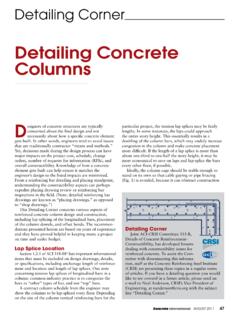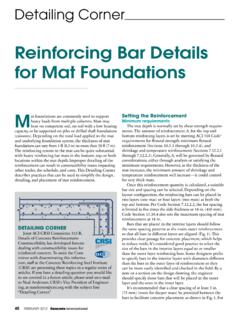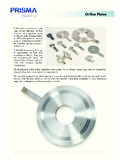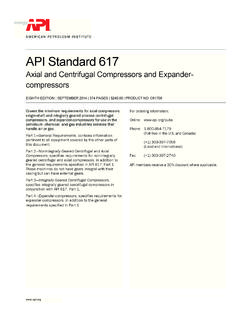Transcription of Base Plate and Anchor Rod Design
1 1 Steel Design GuideBase Plate and Anchor Rod DesignSecond Edition1 Base Plate andAnchor Rod DesignJAMES M. FISHER, , Structural Design , , WisconsinandLAWRENCE A. KLOIBER, Steel CompanyMinneapolis, MinnesotaA M E R I C A N I N S T I T U T E O F S T E E L C O N S T RU C T I O N , I N C .Second Edition Steel Design GuideCopyright 2006byAmerican Institute of Steel Construction, rights reserved. This book or any part thereofmust not be reproduced in any form without thewritten permission of the information presented in this publication has been prepared in accordance with recognized engineering principles and is for general information only. While it is believed to be accurate, this information should not be used or relied upon for any specific application without compe-tent professional examination and verification of its accuracy, suitability, and applicability by a licensed professional engineer, designer, or architect.
2 The publication of the material contained herein is not intended as a representation or warranty on the part of the American Institute of Steel Construction or of any other person named herein, that this information is suitable for any general or particular use or of freedom from infringement of any patent or patents. Anyone making use of this information assumes all liability arising from such must be exercised when relying upon other specifications and codes developed by other bodies and incorporated by reference herein since such material may be modified or amended from time to time subsequent to the printing of this edition. The Institute bears no responsi-bility for such material other than to refer to it and incorporate it by reference at the time of the initial publication of this in the United States of AmericaFirst Printing: May 2006 AISC would also like to thank the following individuals who assisted in reviewing the drafts of this Design Guide for their insightful comments and authors would like to thank Robert J.
3 Dexter from the University of Minnesota, and Daeyong Lee from the Steel Structure Research Laboratory, Research Institute of Industrial Science & Technology (RIST), Kyeonggi-Do, South Korea, for their writing of Appendix A and the first draft of this Guide. The authors also recognize the contribu-tions of the authors of the first edition of this guide, John DeWolf from the University of Connecticut and David Ricker (retired) from Berlin Steel Construction Company, and thank Christopher Hewitt and Kurt Gustafson of AISC for their careful reading, suggestions, and their writing of Appendix B. Special appreciation is also extended to Carol T. Williams of Computerized Structural Design for typing the ArbitrioReidar BjorhovdeCrystal BlantonCharles J. CarterBrad DavisRobert O. DisqueJames DoyleRichard M. DrakeSamuel S. EskildsenDaniel M. FalconerMarshall T. FerrellRoger D. HamiltonJohn HarrisAllen J.
4 HarroldDonald JohnsonGeoffrey L. KulakBill R. Lindley IIDavid McKenzieRichard OrrDavis G. Parsons IIWilliam T. SeguiDavid F. SharpVictor ShneurBozidar StojadinovicRaymond TideGary C. VioletteFloyd J. VissatviviiTable of INTRODUCTION .. MATERIAL, FABRICATION, INSTALLATION, AND REPAIRS ..2 Material Specifications ..2 Base Plate Material Selection ..2 Base Plate Fabrication and Finishing ..3 Base Plate Welding ..4 Anchor Rod Material ..5 Anchor Rod Holes and Washers ..6 Anchor Rod Sizing and Layout ..7 Anchor Rod Placement and Tolerances ..7 Column Erection Procedures ..8 Setting Nut and Washer Method ..8 Setting Plate Method ..9 Shim Stack Method ..9 Setting Large Base Plates ..9 Grouting Requirements ..9 Anchor Rod Repairs ..10 Anchor Rods in the Wrong Position ..10 Anchor Rods Bent or Not Vertical.
5 10 Anchor Rod Projection Too Long or Too Short ..10 Anchor Rod Pattern Rotated 90 ..12 Details for Seismic Design D .. Design OF COLUMN BASE Plate CONNECTIONS ..13 Concentric Compressive Axial Loads ..14 Concrete Bearing Limit ..14 Base Plate Yielding Limit (W-Shapes) ..15 Base Plate Yielding Limit (HSS and Pipe) ..16 General Design Procedure ..16 Tensile Axial Loads ..18 Anchore Rod Tension ..19 Concrete Anchorage for Tensile Forces ..19 Design of Column Base Plates with Small Moments ..23 Concrete Bearing Stress ..24 Base Plate Flexural Yielding Limit at Bearing Interface ..24 Base Plate Flexural Yielding at Tension Interface ..25 General Design Procedure ..25 Design of Column Base Plates with Large Moments.
6 25 Concrete Bearing and Anchor Rod Forces ..25 Base Plate Yielding Limit at Bearing Interface ..26 Base Plate Yielding Limit at Tension Interface ..27 General Design Procedure ..27 Design for Shear ..27 Friction ..27 Bearing ..27 Shear in Anchor Rods ..29 Interaction of Tension and Shear in the Concrete ..30 Hairpins and Tie Rods .. Design EXAMPLES ..31 Example: Base Plate for Concentric Axial Compressive Load (No concrete confinement) ..31 Example: Base Plate for Concentrix Axial Compressive Load (Using concrete confinement) ..32 Example: Available Tensile Strength of a w-in. Anchor Rod ..34 Example: Concerete Embedment Strength ..34 Example: Column Anchorage for Tensile Loads ..34 Example: Small Moment Base Plate Design .
7 37 Example: Large Moment Base Plate Design ..38 Example: Shear Transfer Using Bearing ..40 Example: Shear Lug Design ..40 Example: Edge Disttance for Shear ..42 Example: Anchor Rod Resisting Combined Tension and Shear ..42 REFERENCES ..45 APPENDIX A ..47 APPENDIX B .. INTRODUCTIONC olumn base Plate connections are the critical interface between the steel structure and the foundation. These con-nections are used in buildings to support gravity loads and function as part of lateral-load-resisting systems. In addition, they are used for mounting of equipment and in outdoor sup-port structures, where they may be affected by vibration and fatigue due to wind plates and Anchor rods are often the last structural steel items to be designed but are the first items required on the jobsite. The schedule demands along with the prob-lems that can occur at the interface of structural steel and reinforced concrete make it essential that the Design details take into account not only structural requirements, but also include consideration of constructability issues, especially Anchor rod setting procedures and tolerances.
8 The impor-tance of the accurate placement of Anchor rods cannot be over-emphasized. This is the one of the key components to safely erecting and accurately plumbing the material in this Guide is intended to provide guidelines for engineers and fabricators to Design , detail, and specify column-base- Plate and Anchor rod connections in a manner that avoids common fabrication and erection problems. This Guide is based on the 2005 AISC Specification for Structur-al Steel Buildings (AISC, 2005), and includes guidance for designs made in accordance with load and resistance factor Design (LRFD) or allowable stress Design (ASD). This Guide follows the format of the 2005 AISC Specifi-cation, developing strength parameters for foundation sys-tem Design in generic terms that facilitate either load and resistance factor Design (LRFD) or allowable strength de-sign (ASD). Column bases and portions of the anchorage Design generally can be designed in a direct approach based on either LRFD or ASD load combinations.
9 The one area of anchorage Design that is not easily designed by ASD is the embedment of Anchor rods into concrete. This is due to the common use of ACI 318 Appendix D, which is exclu-sively based on the strength approach (LRFD) for the Design of such embedment. Other steel elements of the foundation system, including the column base Plate and the sizing of Anchor diameters are equally proficient to evaluation using LRFD or ASD load methods. In cases such as anchors sub-jected to neither tension nor shear, the anchorage develop-ment requirement may be a relatively insignificant generic approach in development of foundation de-sign parameters taken in this Guide permits the user a choice to develop the loads based on either the LRFD or ASD ap-proach. The derivations of foundation Design parameters, as presented herein, are then either multiplied by the resistance factor, , or divided by a safety factor, , based on the ap-propriate load system utilized in the analysis; consistent with the approach used in the 2005 Specification.
10 Many of the equations shown herein are independent of the load ap-proach and thus are applicable to either Design methodology. These are shown in singular format. Other derived equations are based on the particular load approach and are presented in a side-by-side format of comparable equations for LRFD or ASD typical components of a column base are shown in Figure selection and Design details of base plates can significantly affect the cost of fabrication and erection of steel structures, as well as the performance under load. Relevant aspects of each of these subjects are discussed briefly in the next section. Not only is it important to Design the column-base- Plate connection for strength requirements, it is also important to recognize that these connections affect the behavior of the structure. Assumptions are made in structural analysis about the boundary conditions represented by the connections.













